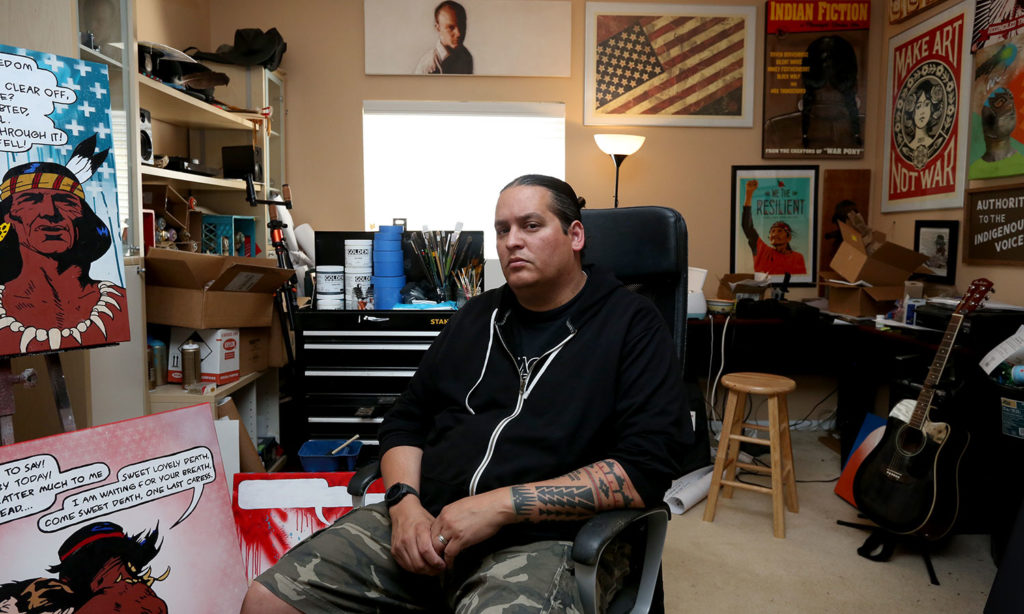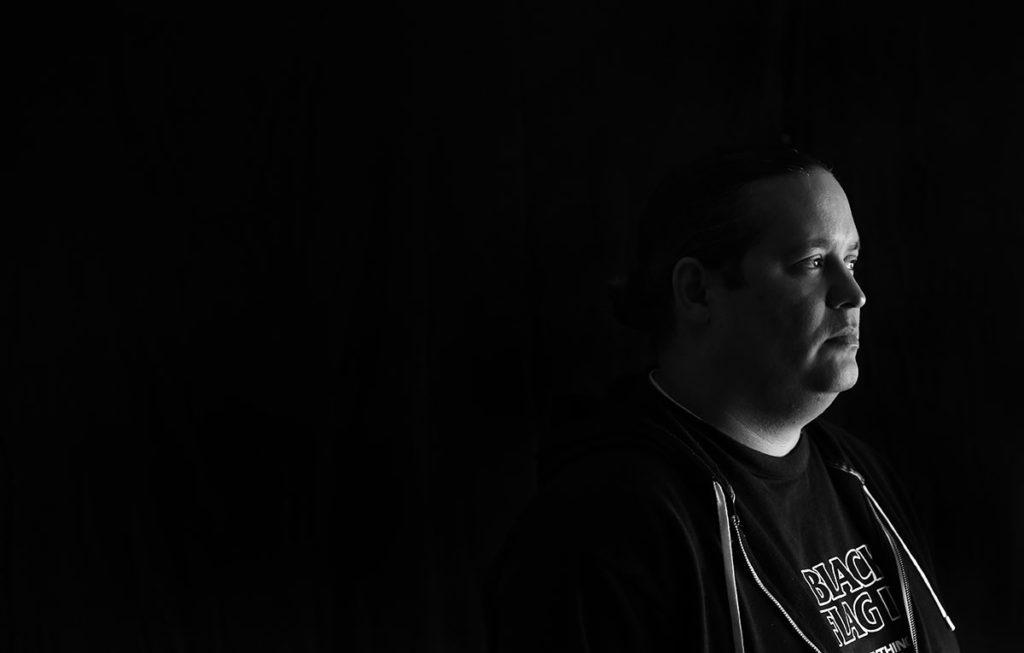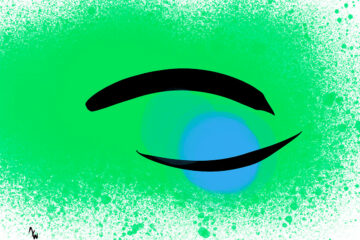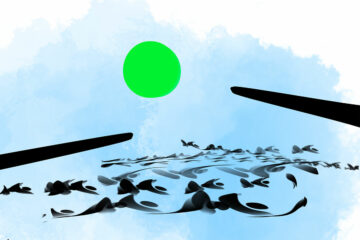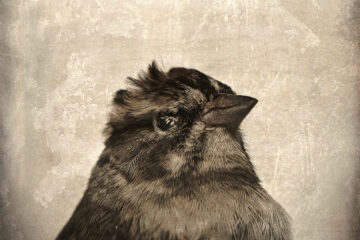In “The Last American Indian on Earth,” Gregg Deal has a lot to say — even when he’s not actually speaking.
Maybe he is existing silently in a public space, walking through a shopping mall or standing on a city sidewalk. Maybe he’s ripping through the scene on one of his kids’ Razor scooters. Or he’s standing to the side, holding a sign with a few choice words.
It turns out that a man wearing a fake Indian headdress made in China raises some eyebrows, provokes. His mere existence disturbs spaces.
Gregg, 44, is a member of the Pyramid Lake Paiute tribe with origins in what is now known as Nevada. Because his painting, performance art and filmmaking communicate through that personal lens on life, his art teems with the oft-dismissed Native perspective.
Gregg’s 2013 performance piece, “The Last American Indian on Earth,” launched him to some measure of prominence as an artist. Media started calling for him.
You might have seen or heard him in national outlets — e.g. Washington Post Magazine, The Daily Show, National Geographic, Huffington Post. You might have watched his TEDxBoulder presentation from last summer.
Or, if you’re plugged into news of the lengthy debate over the use of Native Americans as sports team mascots, you might have noticed Gregg at the forefront of it in Washington, D.C. He lived and worked in the area for nearly 20 years.
In his latest work, Gregg is getting a new series of paintings ready for a show this November at The Fridge gallery in D.C. “Outsiders” matches illustrations of indigenous people fighting back against white men with existing punk-rock lyrics. “Punk rock totally makes sense to Native people,” he says, “in terms of what they’re talking about.”
Gregg sat down in his home studio with Humanitou, surrounded by paintings and other works of his own, and that of friends.
He pulls out and unrolls a fresh print of work made and sent by his friend Shepard Fairey. He points out one of his new Outsiders paintings a rock star had just messaged him to buy, based on Gregg’s recent post of the work on Instagram.
All that is to say: Gregg has a strong voice and a focused presence people are drawn to. He has an immense love and respect for his roots, and an extraordinary depth of knowledge about our shared history as a nation.
And despite who he has come to know, and where his art and voice take him, humility and family — wife, Megan, and their five children — keep him grounded.
Meet Gregg Deal, as we talk about heritage and the prospect of white guilt, and bust stereotypes while charging right at them. [And read the second part of our Humanitou conversation, “Gregg Deal | Truths, Dreams + Reconciliation.”]
Humanitou: As someone of mixed European descent, I don’t feel like I connect to deep roots of heritage. If anything, things feel rooted in commercialism, capitalism. What does it mean to you to be of the Pyramid Lake Paiute tribe and to have that history you speak to so passionately through your work.
Gregg: I think a lot of the struggle for people of color, in particular, and Native people and black folks, especially, there are these interactions that happen that are very much based on a shared experience or shared trauma that is still rooted in culture.
Our light-skinned friends from Europe came here and essentially abandoned culture and assimilated to American culture. And by abandoning those things have abandoned identity and, particularly when people were immigrating here and going through Ellis Island, the abandonment of those cultures was a survival tactic.
That abandonment of those things, I think, means the abandonment of their source, things that help define who they are. So, I think it’s really interesting because the interactions, the arguments ultimately come from two different places: people that are here that are trying to say that this place matters, or that the concepts of capitalism or democracy are the things that matter.
That, ultimately, ends up being the culture. And those are not culture. Those are power systems that exist to essentially run the show.
It’s easy to beat people over the head. It’s easy to tell people that they’re the bad guy. It’s much harder to navigate those spaces in a way that somebody who might be party to the fault can be able to look at something and be able to laugh at it.
There’s something inherently important to hearing your own language and to knowing your own stories, and to being able to connect to those traditions.
Within my work, I’m not trying to create something that’s kitsch. I’m not trying to create shtick or a niche. I’m trying to articulate my experience as an indigenous person. Art happens to be my medium, and this happens to be my life.
Everything I do, everything I have been doing, is connected to something that I see, something that is important to me as a father, as a Native person, something that I’ve experienced.
To own that, to navigate that — because we all have trauma, we all have issues growing up, and even trying to figure out where we fit in politically, socially — I feel fortunate that I have something to help me navigate that, and I’m trying to navigate that in the healthiest way possible.
Humanitou: In your performance piece and film, “The Last American Indian on Earth,” you wore clothing that people all over the world would identify as the universal image of Indianness: headdress, beads, etc. Fake Indian clothes made in China. You wore that while holding one sign or another. One of the signs was: My spirit animal is white guilt.
What was your experience with that piece, with reactions to that?
Gregg: A big part of holding that sign, and a big part of that performance piece in particular, was about disturbing spaces. Sometimes it’s just about being in spaces, and then being disturbed. It goes both ways.
With that sign, I got yelled at a couple times. Most people would read it and laugh. They kind of get it. It would kind of depend on where it was.
I would usually do that sign, specifically, at the Lincoln Memorial. In Washington, D.C., the Lincoln Memorial is like Disneyland. Everybody goes to the Lincoln Memorial.
That sign is not at all me subscribing to the idea of white guilt, because I don’t know if that’s really a thing. I know some people get defensive about things sometimes. Maybe that’s based on guilt. Maybe that’s based on something else. I don’t know.

Contemporary artist Gregg Deal in front of his 36” x 60” painting, “Rise Above (Black Flag),” from his new “Outsiders” series.
I know people get really pissed off about things. Within the realm of the performance work, I think it’s really funny when people get pissed off. Because nothing’s that serious.
There was nothing funnier to me than seeing what seemed clear to me, a conservative white man and his wife and his children from, like, Ohio or someplace in the middle of America, standing in front of me, reading the sign.
I could see his lips moving, actually mouthing the words, “white guilt,” and then rolling his eyes and walking away. I think that’s hilarious, because he’s saying the words while processing what’s happening.
There’s a lot of questions with that, and I like posing questions in spaces where people might not otherwise think about those questions. I have a fair amount of work that does that, disturbing spaces with leaving questions.
I’m always thinking very critically about the spaces that I’m in and what I’m doing, what things mean and why they mean the things we think they mean.
Humanitou: You distill complex messages into impactful, digestible moments for viewers to take in. It takes a lot of work to present complexity simply.
Gregg: James Luna (a fellow Native and performance artist) became a mentor and my friend. That’s what he did. That’s where I kind of starting seeing it.
A lot of people think of Indians as so stoic. Indians are pretty damn funny. There’s this quickness. We give each other a hard time, and you’ve just got to know how to survive through sarcasm and humor.
I think that (white guilt) sign is really funny. It’s very simple and very quick, and a little sarcastic.
I did a mural that says, “American genocide reconciled through football.” In five words I just summarized the ridiculousness of the argument of honor.
“But we do these mascots to honor Native people.” So, you’re telling me after hundreds of years of American genocide everything’s OK, because grown men in tights are tackling each other? That’s ridiculous.
“American genocide” is a very hard and heavy statement, but it sets the tone. And then suddenly that’s “reconciled through football.”
You have to think through that stuff to communicate as quickly as possible the ridiculousness of these various things and the way they exist.
We are the most visible invisible people in the country. Everybody knows who we are, knows what we are, but they don’t know anything about that. We’re not taught about how important those things are in our country.
It’s a coping mechanism. It’s a way to communicate. It also provides different perspective. We’re used to hearing things shouted in an argument on 24-hour news stations. The only way people hear something different is through the means in which they engage.
The Daily Show is a really great example. I was on a panel on The Daily Show talking about the mascot debate. That suddenly became a completely different medium, even though it’s on television, even though it’s a sort of satirical news format, it provided a different perspective. The little bit of humor makes it approachable.
It’s easy to beat people over the head. It’s easy to tell people that they’re the bad guy. It’s much harder to navigate those spaces in a way that somebody who might be party to the fault can be able to look at something and be able to laugh at it.
You have to be smart about the way you present things and you have to look through them in a way that’s not just appropriate for me in the way it’s being articulated, but also appropriate for people to understand it in the quickest and shortest way possible.
Humanitou: I’ve been aware of the mascot debate for some time, and didn’t know you were at the forefront of that in one of, I think, the more contentious locations for it, being with the Washington Redskins.
The team owner, Dan Snyder, has been mind-bogglingly stubborn in protecting the history of his team’s identity while ignoring the history of something so much greater.
Gregg: Isn’t that the disconnect of America, though? In America, especially for people who come from generations of assimilating to American culture, there is this desire to want to belong to something.
Football’s just football. People just want to watch football. They just want to have a good time and they want to belong to a group of people who are fans. It’s not a tribe, but it’s not unlike the sort of makeup of that.
You’re part of an exclusive group of people. You’re all on the same level, you love the same players, you’ve been with the same team as lifelong fans. And I think that points to where people feel like they’re missing something and they gravitate to something like that, which is totally understandable. Also, it’s just fun.
But the disconnect is being able to understand why something that is cultural would ever be a problem. That’s how far removed we are from understanding any of those things.
Part of the issue of any issue that comes from a marginalized group of people that don’t have a dominant voice in society is helping people to understand the context. And for Native people, it’s worse than anybody, because we are the most visible invisible people in the country.
Everybody knows who we are, knows what we are, but they don’t know anything about that. We’re not taught about how important those things are in our country.

Two works from Gregg Deal’s new series, “Outsiders,” which pairs illustrations with existing punk-rock lyrics. Left: A photograph (by the artist) of the painting, “That’s Progress (D.O.A.).” Right: A digital sketch for his painting, “Last Caress (Misfits).”
Like I say in my TED talk, we know who Christopher Columbus is but we don’t know who the people he came into contact with are. It was the Taíno people, but that’s not taught. And then you begin to give weight to things as a result of that.
Columbus matters because he came from Europe and is benevolently discovering — even though we all know he was lost at sea. But these people came into contact with him and, “He just came into contact with some people. It doesn’t really matter.”
That sets the stage for everything we know. The only understanding or knowledge people have of Native people are movies and books and romance novels. You know, Kevin Costner, maybe some John Wayne. More recently, we’ve got Johnny Depp and Daniel Day-Lewis.
By the way, the white Indian is the most Indian Indian that was ever Indian (as portrayed by Hollywood). He’s more Indian than any Indian is. Daniel Day-Lewis runs faster and can shoot straighter than his Indian Indian co-stars. This is the phenomenon that’s built.
So that becomes the frame of reference, and those frame of references are completely Hollywood. They’re false. They’re made. Which means that everything that everybody thinks they know about indigenous people is false.
And what’s mind-blowing about that is the only way I can explain something new that is true is that I have to use those falsehoods as a basis so I can help you understand something I’m trying to explain to you. So, even my truths are muddled in falsehoods.
Humanitou: Hollywood has a long history of typecasting non-white people. Every group has been reduced to a caricature, and each has had to overcome that for equality on the screen. To accept work as the caricature can create tension within one’s own community, yet you head right at the stereotypes with what you do.
Gregg: It’s about owning the stereotype. And not owning it, necessarily, in a positive way but acknowledging that it’s there and dismantling it for what it is.
What I’m wearing in “The Last American Indian on Earth,” what’s the difference between an Indian wearing fake Indian gear and a non-Native person wearing fake Indian gear? One is well-informed in culture and understanding, and the other is informed by white perception.
And I say “white” because that has been the dominant ruling group of people in this country, and it’s not meant to be derogatory. It’s simply meant to be true in understanding the way that this country has been built, and all its power structures.
There’s a frame of reference there. In me embodying the stereotype, it changes the stereotype. It changes what you’re looking at, in terms of owning something and publicly twisting it in a way that dismantles it.
My greatest fear was that I was going to run into another Native person. Which happened twice. And I talked very quickly. “Ok, thisiswhat’shappening …” like, trying to explain what’s going on, because it looks terrible.
Some people would react terribly. There was a woman at, sort of, the apex of the film that starts telling me, “Who the hell do you think you are? I’m part Cherokee. You have no right to dress like this,” not realizing that Cherokees don’t dress like that.
Everything she’s saying, regardless of who she is, regardless of her race, regardless of anything, has to do with this dominant perception and the need to confront something based on that perception.
There’s a couple perceptions that are happening towards Native people. One is romanticism. And then the other one is on the left side of things, the well-meaning liberal that’s trying to regulate what other people are saying or not saying.
And so the woman in the film comes at me and on one side, she’s sort of on that defend-Native-people, progressive thing. And then suddenly turns to being just based in romanticism in the way that she’s talking to me and engaging me.
And a lot of it goes that way. I saw a guy that was like, “That’s not a real Indian.” I walked up next to him and said, “So … I’m a real Indian.” So much of what that points to is the idea that my identity is based on others’ perceptions.
My identity is not based on other perceptions but other people believe their perception means more than my own definition of myself. It’s like, “You don’t really look Indian.” Which I hear all the time. I know full-blooded Indians who’ve heard that in their lifetime.
Humanitou: Well, what does an Indian look like?
Gregg: Right! And in our limited understanding of what an Indian looks like, it’s a dominant nose, high cheekbones, reddish-brown skin. High cheekbones denote, probably, a strong jaw, a strong face.
If you look at the Mohawk, they look kind of like that. They’re a little more chiseled in their facial features whereas my people have fat, round faces.
The creation of this pan-Indian image that has been touted throughout history has been used to sell dime novels, to sell movie tickets, to do all these other things, but it’s not rooted in reality.
There’s 573 different tribes in the United States that are recognized by the federal government, and then there’s several hundred more that are not federally recognized but are usually recognized by the states that they reside in.
There’s over 300 different languages and different dialects within those languages. My people speak a similar language as the Ute but the dialects are so different you can’t really understand each other.
And so you have that many different creation stories, you have that many different traditions, you have that many different songs, different ideas, concepts. Yet, we’re all pigeon-holed to this headdress image.
(On using humor as a tool) Somebody said to me, ‘Wow, you’re not angry at all.’ No, I’m totally angry. I’m just trying to articulate it in a more constructive way.
Of that 573 tribes, maybe, maybe, a dozen of them traditionally wear headdresses the way that most Americans know headdresses. Yet, that is the quintessential image of who and what we are.
So, wearing that headdress and dressing like that stereotype is, basically, an Indian playing a joke on everybody. It’s a social experiment. It’s “Indian Jackass.” I’m just messing with people.
And because people will come up, like the woman that’s talking to me in the film, and she’s like, “What’s your Indian name?” I said, “It’s Gregg.”
She’s like, “No, no. It has to be something else like Red River or Running Cloud, or something.” I told her, “It’s Walking Eagle.”
She’s like, “Oh, wow! That’s amazing. Is that real?” I’m like, “Yeah, that’s totally real.”
“Walking Eagle” was this joke from this Indian comedian. His name was Charlie Hill. He has this joke that the only time you name somebody Walking Eagle is when they’re too full of crap to fly. That’s the only time an eagle walks is when they’re too full of crap to fly.
And so that woman takes that and she’s like, “Oh, my gosh. That’s amazing,” and doesn’t realize that it’s just a joke. So, it’s using the stereotype to play jokes on people — but there’s still a very serious social and cultural component to it.
Humanitou: Without humor as a tool, the anger would consume you, consume all of you. It would consume all of us together.
Gregg: Somebody said to me, “Wow, you’re not angry at all.” No, I’m totally angry. I’m just trying to articulate it in a more constructive way.
The angsty teenager that was listening to punk and hip-hop, and skateboarding, and going to shows and fighting skinheads is still in me. But it’s about trying to articulate things in a way that’s more constructive.
The Humanitou conversation continues next week with “Gregg Deal | Truths, Dreams + Reconciliation.” In the meantime, watch Gregg’s short film, “The Last American Indian on Earth.”
